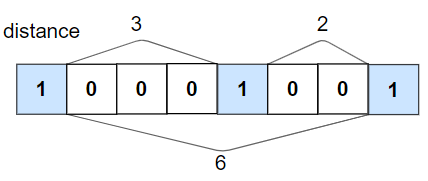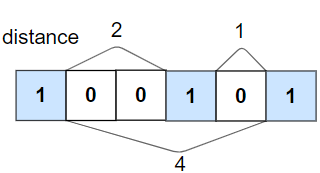2021-01-25 Daily-Challenge
Today I have done Circular Array Loop, Letter Tile Possibilities and leetcode's January LeetCoding Challenge with cpp.
Circular Array Loop
Description
You are given a circular array nums of positive and negative integers. If a number k at an index is positive, then move forward k steps. Conversely, if it's negative (-k), move backward k steps. Since the array is circular, you may assume that the last element's next element is the first element, and the first element's previous element is the last element.
Determine if there is a loop (or a cycle) in nums. A cycle must start and end at the same index and the cycle's length > 1. Furthermore, movements in a cycle must all follow a single direction. In other words, a cycle must not consist of both forward and backward movements.
Example 1:
Input: [2,-1,1,2,2]
Output: true
Explanation: There is a cycle, from index 0 -> 2 -> 3 -> 0. The cycle's length is 3.
Example 2:
Input: [-1,2]
Output: false
Explanation: The movement from index 1 -> 1 -> 1 ... is not a cycle, because the cycle's length is 1. By definition the cycle's length must be greater than 1.
Example 3:
Input: [-2,1,-1,-2,-2]
Output: false
Explanation: The movement from index 1 -> 2 -> 1 -> ... is not a cycle, because movement from index 1 -> 2 is a forward movement, but movement from index 2 -> 1 is a backward movement. All movements in a cycle must follow a single direction.
Note:
- -1000 ≤ nums[i] ≤ 1000
- nums[i] ≠ 0
- 1 ≤ nums.length ≤ 5000
Follow up:
Could you solve it in O(n) time complexity and O(1) extra space complexity?
Solution
note that there range of nums[i] is [-1000, 0) $\cup$ (0, 1000], so we can use rest of number of int to represent vis[] and currentVis[], I want to write this and use optimization trick, but I don't have enough time...
class Solution {
public:
bool circularArrayLoop(vector<int>& nums) {
int len = nums.size();
vector<bool> vis(len);
for(int i = 0; i < len; ++i) {
if(vis[i]) continue;
int pos = i;
int positive = nums[i] > 0;
vector<bool> currentVis(len);
while((nums[pos] > 0) == positive && !vis[pos] && !currentVis[pos]) {
cout << pos << ' ';
currentVis[pos] = true;
pos += nums[pos];
// cout << nums[i] << ' ' << pos << endl;
if(pos < 0 || pos >= len) pos = (pos%len + len) % len;
}
if(currentVis[pos]) {
int cirLen = 0;
int point = pos;
fill(currentVis.begin(), currentVis.end(), false);
pos = ((pos + nums[pos])%len + len) % len;
while(pos != point) {
pos += nums[pos];
if(pos < 0 || pos >= len) pos = (pos%len + len) % len;
cirLen += 1;
}
// cout << "len: " << cirLen << endl;
if(cirLen) return true;
}
pos = i;
while((nums[pos] > 0) == positive && !vis[pos]) {
vis[pos] = true;
pos += nums[i];
if(pos < 0 || pos >= len) pos = (pos%len + len) % len;
}
}
return false;
}
};
oh, slow/fast pointer!
Letter Tile Possibilities
Description
You have n tiles, where each tile has one letter tiles[i] printed on it.
Return the number of possible non-empty sequences of letters you can make using the letters printed on those tiles.
Example 1:
Input: tiles = "AAB"
Output: 8
Explanation: The possible sequences are "A", "B", "AA", "AB", "BA", "AAB", "ABA", "BAA".
Example 2:
Input: tiles = "AAABBC"
Output: 188
Example 3:
Input: tiles = "V"
Output: 1
Constraints:
1 <= tiles.length <= 7tilesconsists of uppercase English letters.
Solution
I found it is hard to using dynamic programming to solve it. but data range is small enough for DFS.
class Solution {
map<char, int> cnt;
int answer = 0;
int suffix[128] = {0};
int cntArr[128] = {0};
int permutation(int m) {
int result = 1;
while(m > 0) result *= m--;
return result;
}
int compute(vector<int> &helper, int all) {
int result = permutation(all);
for(auto i : helper) result /= permutation(i);
return result;
}
void dfs(vector<int> &helper, int rest, int all, map<char, int>::iterator it) {
if(it == cnt.end()) {
if(rest == 0) {
// cout << compute(helper, all) << endl;
answer += compute(helper, all);
}
return;
}
char c = it->first;
for(int i = max(0, rest - suffix[c]); i <= min(it->second, rest); ++i) {
helper.push_back(i);
++it;
dfs(helper, rest-i, all, it);
--it;
helper.pop_back();
}
}
public:
int numTilePossibilities(string tiles) {
int len = tiles.length();
for(auto c : tiles) {
cnt[c] += 1;
cntArr[c] += 1;
}
for(int i = cnt.rbegin()->first; i >= cnt.begin()->first; --i) {
suffix[i] = suffix[i+1] + cntArr[i+1];
}
// for(int i = 'A'; i <= 'Z'; ++i) cout << suffix[i] << ' ';
vector<int> helper;
for(int i = 1; i <= len; ++i) {
dfs(helper, i, i, cnt.begin());
}
return answer;
}
};
January LeetCoding Challenge 25
Description
Check If All 1's Are at Least Length K Places Away
Given an array nums of 0s and 1s and an integer k, return True if all 1's are at least k places away from each other, otherwise return False.
Example 1:

Input: nums = [1,0,0,0,1,0,0,1], k = 2
Output: true
Explanation: Each of the 1s are at least 2 places away from each other.
Example 2:

Input: nums = [1,0,0,1,0,1], k = 2
Output: false
Explanation: The second 1 and third 1 are only one apart from each other.
Example 3:
Input: nums = [1,1,1,1,1], k = 0
Output: true
Example 4:
Input: nums = [0,1,0,1], k = 1
Output: true
Constraints:
1 <= nums.length <= 1050 <= k <= nums.lengthnums[i]is0or1
Solution
class Solution {
public:
bool kLengthApart(vector<int>& nums, int k) {
int pos = -1e5;
int len = nums.size();
for(int i = 0; i < len; ++i) {
if(nums[i]) {
if(i - pos < k+1) return false;
pos = i;
}
}
return true;
}
};